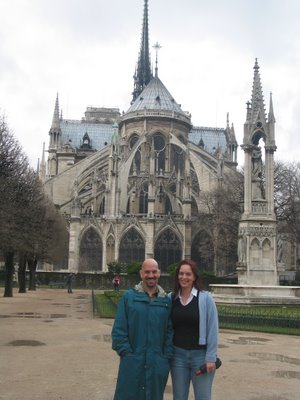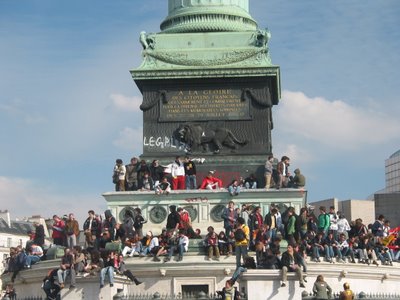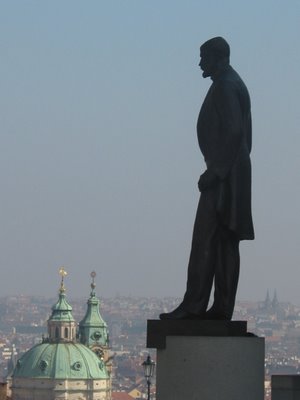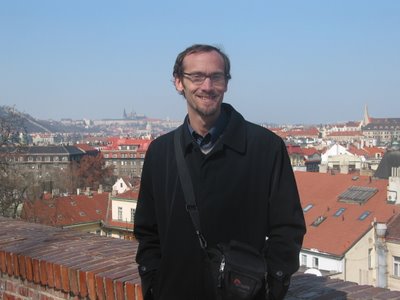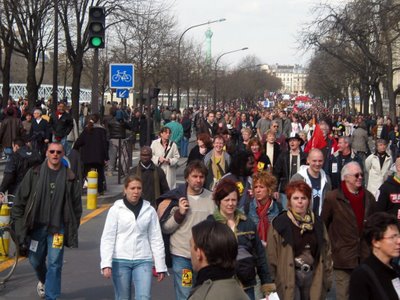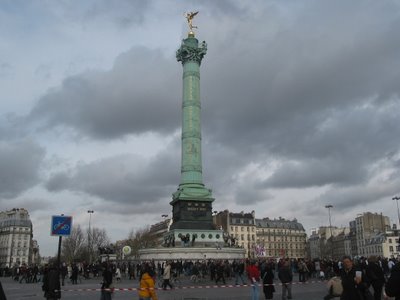Au revoir
The world's tallest cliché. How many million times have these pictures been taken? I certainly recommend seeing it at night.
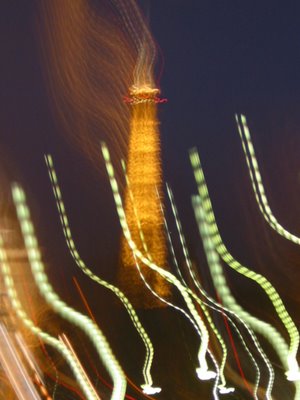


This may be my last message from France as I am leaving in a few days. I perhaps may issue a valedictory address next week upon my return...
The last few days have been busy as it has hit me that I leave soon and still have some things to finish up.
I awoke a couple of days ago to a morning of cold, gray drizzle reminding me of February. I trudged down to my station with all the other Métro-riding drones. As usual, the wait for my first train was short and I boarded with the others to a half-filled compartment. Rather than sit, I stood, as I am taking a new route to the BN as my second train, the 14, is closed for the next several days as the line is being extended one stop past the BN. My new connecting line, the 6 (Etoile-Nation) is only two stops away and it is scarcely worth the trouble of sitting. The connecting hub station, Nation, is much smaller than my old hub, the Gare de Lyon and I have just a one-minute walk to my connecting train.
The 6 line feels more working class than the 1 or the 14. The trains are older as each car is independent of the rest and the doors do not open automatically. Also, one notices a much more worldly mix of passengers from all countries and social levels as opposed to the somewhat bourgeois 1. Moreover, the line itself is a rougher ride with some tighter turns and bumpy spots. One good thing about my new line though is that when I change trains at Nation it is at the line's beginning (or end as the case may be) so the train sits and waits to be filled and then leaves the station, usually in two to three minutes. Most mornings of my connection I can get a seat (it is a six-station ride to another station nearest the BN) so I can wear the "Continental" mask in relative comfort for the fifteen-minute ride. This particular morning I was not so lucky. I walked up the steps from my line and found a train waiting in the departure lane. However, the train was already mostly filled with passengers. Odd. I found a compartment and entered. The older trains have six sets of sliding double doors, three pairs to a side. Beside each door are two strapontins (maybe jumpseats in English) that one can press down the spring-loaded seat from the vertical to the horizontal so one can sit down. Riders who take just a few stops usually sit in these temporary seats and they tend to take the "defender" position. When the cars fill those seated have to stand to make more room so on crowded times these seats are rarely used. The prime seats are behind the strapontins, four pairs of double seats facing each other. Riders who are on the Métro for more than a few stops prefer the relative comfort and convenience of those seats. I have noticed that readers especially favor them.
Two strapontins were left and I sat down on one of them, looking bored with life: oh, the pain of living in Paris. I, along with the rest, waited. And waited. After two minutes the driver asked us for our patience as "a passenger has become ill" on a train many stops ahead (well past the BN stop). I was not really sure what that cryptic message meant but as we waited more passengers emerged from the bowels below the station waiting for a new train and they lumbered into my compartment. At this point it was too crowded to sit and one by one the eight strapontin riders, including myself, stood with a grumble. However, and thankfully, the horn blew, the doors closed and we were off after perhaps a five minute delay. I was not particularly worried as this day I was on my own schedule and had no worries about being "late" to work.
Unfortunately, the delicate timing and coordination of our line was now terribly off. I could come up with some metaphor like a trapeze artist and partner but I am not sure that quite fits but one gets the idea. My compartment was now officially crowded, but not unpleasantly so: I at least had six inches of "personal space." I balanced myself against the non-opening doors behind me and a now-vertical strapontin to my left. We made it to the next stop, Picpus, and I saw this usually empty station with more passengers than before. The doors opened and six more came into the compartment. The doors closed and we left my personal space down to five inches. The train went forward, though slower than usual, perhaps because of the crowded compartments. The next station, Bel-Air (outdoors, rather than underground) saw an even larger crowd awaiting. Another five came in my particular area. Personal space: four inches. Dugommier and Dausmenil followed with even more passengers. I had never seen so many people in a station…with the timing thrown off and more and more passengers "missing" their train because of our delay I could now see a surly crowd at the station, some five ranks deep, all wanting to get on our particular train. And more potential passengers (all a bit damp and certainly all crabby looking) were coming up the stairs to be greeted by an unfriendly crowd. Six more squeezed in: personal space, One half inch. I thought I could smell wet dog.
At the next stop, Bercy, things almost became comical. It is no myth that Tokyo subways have professional, white-gloved "pushers" (I am sure there is an official name for them) whose job is to push people into train compartments during rush hour. The French have no need of them: they push themselves in the train. At Bercy there was literally no space in my compartment. I certainly by this time was well acquainted with the four passengers around me. When we stopped I could see a crowd, eight people deep awaiting a train. As the doors opened and some more tried to get in I heard some female voice plaintively cry out "please wait for the next train!" Someone else asked to open the small long windows at the atop of the larger passenger windows so we could get some fresh air. One man, the bulldog, did not listen to or care for that woman's plea as he, ass-backwards, began to bull his way into the compartment. I was certainly glad I was not near the opening doors as I had no desire to become intimate with him. My morning had become a demented form of transit Twister. When the doors tried to close they hit his shoulders so he pushed back even more: personal space now, negative three inches as I was inhaling in my muffin top to make more room.
Of course now it did not really matter how bumpy our ride was now as I had a living airbag of other passengers around me. If perhaps I could have lifted my legs somehow I would not have fallen down. The train groaned into my destination stop, the Quai de la Gare (another outdoor stop, this time elevated, see the picture far below). The doors opened and it is a good thing that I am about as wide as Barney Fife for I have no idea how I could have gotten out of that train otherwise. I poked and prodded my way out with my hands in front of me held as a "V" so I could use the power of a wedge to make my escape grunting out a few "pardon's" as I went. Just like the bulldog I was going to get out no matter what as I shed my normal Anglo-Saxon reserve.
I took a breath of fresh air and took my walk to the BN. This new station is only a couple of blocks farther away from the BN than my old station and on this day I appreciated the five-minute walk to shake off the feelings of entrapment and claustrophobia. Even the mild drizzle felt good. While never coming close to panicking I can safely say at a few moments I at least felt nervous. By the time I reached the BN those feelings mostly passed and I was processed and readied for my day's work…
This day of work had its own annoyances interesting distractions. I sat at a large wooden table that has five places on each side so ten readers can work at once. Each place has a lamp affixed to the table and also a plug as nearly everyone has a laptop. The materials and the construction are not cheap and one feels a sense of solidity. The reading rooms at the BN are mostly composed of such tables and I would hazard that on one side there are fifty rows of these tables stretching out in the distance, only to be broken up every ten rows by "stations" where one goes to pick up books and materials from the BN staff.
Surrounding us are elephantine poured concrete columns that stretch up six stories to the ceiling creating a cathedralesque impression. The carpet, orange-red, mutes the sound of passersby.
That day I was reading another trade journal, Vente et Publicité. Three others were seated around me this particular morning. Puffy the whale sits across from me. Puffy is not especially large, but I have crowned him "Puffy" because every twenty seconds he emitted some loud breath of moist air from his blowhole as he read his various books strewn about his workplace (he is a philosopher based upon his reading selection). I thought about timing those puffs of air as they seemed most regular at one time but I thought better of it…
Next to me was "Hurricane Alice." "Hurricane Alice" had several quite large folios of 18th century books whose pages are nearly as large as a daily newspaper. Like me, she was quick reader or a scanner and she would turn the pages quite vigorously. As a result a "whoosh" of air descended upon me with the turning of each page. I was assured of good ventilation that bordered on the chilly as the paper crackled from her quick perusings.
On my left is "Clicky." Clicky, chunky man in his mid fifties, is the rare reader who does not have a laptop. Instead, he had a Bic pen (did you know that the Bic pen was invented by a French industrialist, Baron Marcel Bich?) "Clicky" was taking notes from his book and he liked to click, emphatically and triumphantly, his pen after he wrote each sentence. Every sentence to "Clicky" seemed to be an Archimedean "eureka."
As a result, at time that morning I lost concentration as the day progressed with: puff…whoosh…click…puff…whoosh…click…puff…whoosh…click. It was a bit comical at first and some times the sounds had a metronomic regularity. However, after about a half hour of this, what had first seemed amusing turned into distracting then annoying and then finally aggravating.
And, then, of course, there is me. I am sure my fellow readers might have some complaints about me. One of my many flaws is my inability to sit still for any period of time. If anyone has attended a movie with me one would witness countless gyrations during the film as I try to find a comfortable position. At the BN I am like a hyperkinetic hamster as I think my record of sitting still is about fifteen minutes. Between those sittings I find myself going to the electronic catalogue to find some other material, walking next to the glass enclosed 'forest' in the ambulatory, trying to get something photocopied.
By one p.m. I had had enough and I still had some errands to do so I turned in my materials and was "reprocessed" so I could leave the BN. I stopped at home briefly to pick up a shopping bag of fifteen or so books I had either bought or brought with me to France: there is no way I could lug them to London and then back to the US. As it was only mid afternoon it was an ideal time to go to my sleepy branch. I entered and was pleased to see just a couple of people in line for the two postal clerks. After a two-minute wait it was my turn and I told the clerk of my need to send my books home to the US at the most economical rate as speed was not important.
This request spurred a flurry of activity. I do not think there are many such requests done in my neighborhood and there seemed to be some confusion about the process. The pleasant and helpful clerk asked to see my books and I brandished my plastic shopping bag, bulging with pointy books to her as proof. She nodded and disappeared into a back room through a windowless door. At this point more people started to flood into the office (perhaps lunch time had ended) and a line started to fill in behind me.
After at least three minutes Madame returned with a piece of cardboard from a box, somewhat irregularly shaped, three by six inches and pushed it through the glass window (the French post offices also serve as banks so the clerks can also serve as "tellers") and instructed me to write my delivery address. This seemed a bit odd but who was I to argue and I tried to print my address as clearly and as boldly as possible without puncturing the rather thin cardboard. Then, Madame disappeared again. I know I am imagining it but I could feel the line of some twelve people behind me starting to resent me as I was keeping them from their business with my prolonged transaction. My head began to hurt so perhaps someone behind me was psychokinetically shooting gamma rays at my head.
Madame returned from the back room and asked me for my books and I put the bag in a circular revolving window and she rotated the window around and then took them to the back room again disappearing for a few minutes. During this time I noticed the woman in the other line to my right was in the process of some complicated transaction herself so there was no movement at all in the line. She was a sweet elderly woman that no one could dislike so as a result the hostility of the line was borne full brunt upon the simple foreigner.
A last time a smiling Madame returned from the back room and told me everything was set. Suddenly, the whole transaction seemed suspiciously easy. I did not have to do any packing or sealing or fill out some importation/exportation form. Was this all a joke? Were postal clerks in the back reading "Trois siècles de publicité en France" and getting ready to divy up the rest for their home libraries? It was no longer funny when Madame sat down and then clicked a few buttons on her computer bringing up a monetary total on a screen by my face that was equal to the gross national product of several sub-Saharan countries. I gulped. I did not have that much cash with me. It was too late now to reconsider and then ask to have my books back--I could have brought on a postal riot against me. I asked Madame if they took credit cards and she said yes so relievedly I gave her my card.
Of course, you know what happened: the French postal service only takes French-style credit cards with a special chip implanted in them. It became five degrees warmer in the office. I told Madame that I only lived three minutes away and could return with the 117 Euros. She smiled (as she had my books) and I scuttled away, avoiding the eyes of those in line behind me. A quick run home found me going through my pockets to come up with that much money as I am leaving soon I was trying to run out of Euros.
I returned to the branch and of course went to the back of the line. A bolder person (or a French person) would have probably cut in front of the eight others but I had done enough damage. I did notice that the grandmotherly woman was still making her transaction. After ten minutes of waiting it was my turn again and I put 120 Euros through the glass window. Madame was a bit puzzled: the bill was not that much. Then she nodded to herself and told me that the 117 total was the old French Francs amount (by law France still posts prices still in Euros and in Francs so people can make the mental adjustment still). Some how that number had come up on her screen as opposed to the Euro total, an incredibly reasonable (that is if my books ever make it) 16 Euros. Of course, I had had that much money with me to begin with. And if it did arrive, would it arrive via burlap bag and burro?
Combining this with the morning's Métro aggravation and the library's distractions I felt like taking out a hatchet (or buying one as I now had plenty of cash) and running amok, sans culottes, down the Champs Elysées to wreak havoc...
